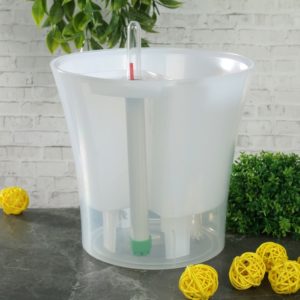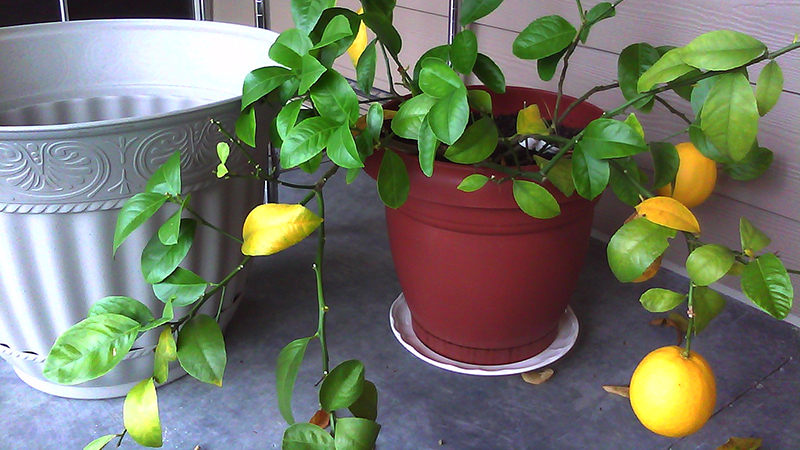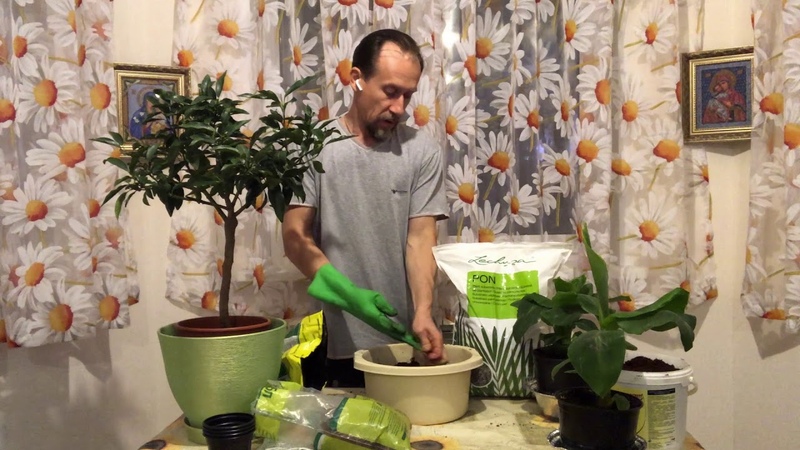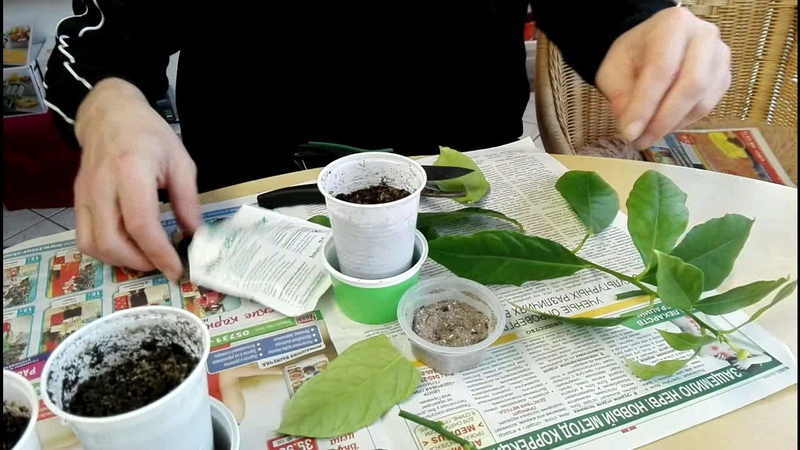How to properly transplant lemon at home
Lemon takes root well and develops quickly even at home. In order for it to bear fruit, and not just be a beautiful tree, it is important to follow the rules of agricultural technology. Lemon care is not only about feeding, watering, forming and creating optimal conditions in the room, but also regular transplants. It depends on the size of the pot how the plant develops correctly.
Lemon is transplanted regularly, regardless of its condition. In some cases, an unscheduled replacement of the pot and soil is carried out. In what cases it is necessary and how to properly transplant a lemon, read on.
The content of the article
When to transplant lemon

Lemon Treegrown at home requires regular transplants. Citrus cannot be planted immediately in a large pot, otherwise its root system will not be able to absorb a sufficient amount of trace elements and will develop incorrectly. This will result in a lack of flowers and fruits.
Another reason for the need for regular replanting concerns the soil. Over time, insoluble compounds are formed in the old soil, remaining from the applied dressings. The composition of the soil changes for the worse. The plant can no longer absorb nutrients. This becomes the cause of leaf fall and death.
In some cases, unscheduled transplants are used. They are necessary if the tree hit by diseases and pests. Sometimes the procedure is carried out after a long violation of the rules of care and leaf fall.
Planned transplant
A planned transplant is carried out regardless of the condition of the lemon. The period between treatments for plants of different ages is not the same:
- 1 year. In the first year, the young plant is moved to a new pot 2-3 times. The first time this is done after rooting the seedlings or the appearance of 2 real leaves on the seedlings. The rest of the transplants are done after the roots fill the pot.
- 2-5 years old. Before flowering, the lemon is transplanted annually.
- Plants that bloom and bear fruit. A pot of an adult lemon, which has bloomed and bore fruit, is renewed once every 2-3 years.
Unscheduled transfer
An unscheduled transplant is done regardless of whether the roots have filled the pot. This is done in the following cases:
- Root rot. This disease affects the roots of the plant, causing them to rot. Outward signs are revealed when the disease is already running, and the lemon has begun to shed its leaves. It is treated only by transplanting into new soil with the preliminary removal of the affected roots.
- Excessive watering of the soil. This changes the composition of the soil, and the roots of the lemon begin to rot. To save the plant, it is transplanted into new soil. A similar problem is signaled by waterlogged boggy soil and yellowed leaves.
- The plant has dropped its leaves... If there are no signs of diseases and pests, as well as mistakes in care, the tree is taken out of the pot. Perhaps it's the root system. Even if this is not the case, the tree often feels better after replanting.
- Water quickly flows into the sump or stagnates. This indicates the wrong composition of the soil. We'll have to transplant the plant and replace the land.
- Increased acidity of the soil... Lemon loves slightly acidic soils. If the indicators turned out to be increased, the problem is solved by transplanting the plant into soil with the addition of lime or ash.
An unscheduled transplant is possible at any time of the year. You cannot wait for the right moment, otherwise it will not be possible to save the plant.
Note! In the cases described, it is possible to transplant to a new place even a flowering and fruiting lemon. Since there is a need to cleanse the roots from the ground, before the procedure, inflorescences and fruits are plucked from the tree.
Replacement of soil and pot immediately after purchase
There is an opinion that the lemon must be transplanted immediately after purchase. This makes sense, as the soil from the store can be contaminated. In addition, often the pots in which the lemons are sold are substandard or too small.
How to understand that a transplant of a purchased lemon is necessary:
- Examine the root system. If roots fall out of the drainage holes or the root system is visible through the holes, then it is necessary to replace the pot with a larger one.
- Stick the skewer into the moistened soil. If it goes tight into the ground and clings to the roots, a transplant is necessary.
- Acidity check. In stores for planting lemons mixtures with high-moor peat are often used. Such soil has a high acidity, unacceptable for lemon. The earth is checked using a litmus test. If the indicators are increased, the soil is replaced with a new one.
If, after such checks, doubts remain about the need to transplant a lemon, the tree is removed from the container along with a lump of earth, the root system and soil are examined.
If the earthen lump is completely covered with roots and there are dry, darkened and slimy areas in the root system, it is worth replanting the plant. If the roots in a coma are not visible and it is falling apart, you need to take a large container.
It is categorically impossible to make a transplant if the plant is a trunk with several leaves. This is a rooted stalk. It is transplanted when the roots fill the entire space of the pot.
Note! To prevent the lemon brought from the store from infecting other indoor plants, in the first week it is quarantined in a separate room and treated with fungicides and insecticides.
Lemon transplant timing

It is best to replant lemon before active vegetation. This is done in late February or early spring. In the fall, such a procedure is carried out only if absolutely necessary. Experienced citrus growers advise paying attention to the indicators of the lunar calendar.
When to transplant lemon at home in 2020:
- January - 1, 5, 6-8, 25, 27-29;
- February - 1-3, 6-7, 9, 20, 23-25, 28-29;
- March - 1, 4-6, 9, 17-18, 24, 27-28.
Preparatory work
For the transplant to be successful, it is important to properly prepare for the procedure. Attention is paid to the soil, the pot and the plant itself.
Pot selection
The correct container lets air into the soil and looks aesthetically pleasing.
What kind of pot is needed for lemon:
- Plastic transparent cups... They are convenient to use in the early stages of lemon growing, when it needs to be replanted several times a year. The plant is transplanted as soon as the roots fill the container. The degree of root growth is visible through the transparent plastic. The glass must be wrapped in a dark cloth, and drainage holes are made in the bottom. In the second year, they use real pots.
- Clay pots. This is the best option for growing lemon. When the soil is wet, the clay absorbs some of the water, and after the soil dries up, it gives back the liquid. It is believed that air enters the soil through the smallest pores in the clay container. Such a container is soaked before planting for several hours in warm water. Then it will not contribute to the premature drying of the earth.

- Plastic pots... The cheapest option that looks aesthetically pleasing. They are convenient for young trees that are transplanted into a new container every year. It should be borne in mind that plastic does not absorb moisture, and a thicker drainage layer will have to be poured into such a pot.

- Wooden tubs with a narrow bottom are used for mature plants. In them, the root system feels as comfortable as possible for a long time. Before use, the inner surface of the tub is burned with a blowtorch to reduce the likelihood of wood decay and disinfect it. The most durable are pine and oak pots.

As for the size of the container, the first pot is chosen with a volume of 0.3-0.5 liters. Further, the diameter of the container is increased each time by 3-5 cm.
Before use, the pots are disinfected - soaked in a dark pink solution of potassium permanganate or boiling water.
Important! The lemon pot must have drainage holes.
Soil preparation
Loose soil is suitable for lemon. It is important that the acidity is neutral or slightly acidic. The indicators are checked using a litmus test.
Some gardeners prepare their own soil mixture.
Ingredients for one of the options:
- garden soil - 2 parts;
- river sand - 1 part;
- sod (forest or meadow) land - 1 part;
- humus - 1 part.
Add 1 tbsp to the resulting soil mixture. ash. It is disinfected by pouring a dark pink solution of potassium permanganate or a product prepared from 5 liters of water and 1 tsp. copper sulfate. Another option is to ignite the soil mixture in the oven.
It is not recommended to use peat for soil. It increases acidity. This is especially true for high-moor brown peat.
Note! White or gray sand is suitable for preparing the soil mixture. It is better not to take yellow and orange, as they have too high an iron content.
Drainage will also be required. Usually they use small expanded clay or crushed stone, small ceramics, shell rock. Drainage is also disinfected.

Preparing the tree
Not only the soil and containers need preparation, but also the plant itself. Before moving the tree to the pot, water it and feed.
Top dressing is applied 5 days before transplanting. If using the transshipment method, water the lemon 2 days before the procedure. To successfully transplant the plant, the soil is moistened 1 day before the procedure.
Step-by-step instructions for transplanting
Transplant methods vary. Different technologies are used for lemons of different ages.
If the tree is already blooms and bears fruit, act as follows:
- The day before moving to a new pot, the lemon is watered abundantly. This makes it easier to clean the root system of soil. The plant is removed from the pot. Remove at least 60% of the old soil.
- Examine the root system. Dry, decaying, brown and damp roots are removed. Places of cuts are treated with a light pink solution of potassium permanganate.
- A layer of soil and drainage are poured into a new container. Lemon is planted without deepening the root collar.
- The soil is watered with a light pink solution of potassium permanganate and a solution of a root formation stimulator.
The transplanted lemon is placed in a warm, bright place where the risk of exposure to direct sunlight is minimal. The first 4-5 days it is not watered, but abundantly sprayed from a spray bottle. Then the daily moistening of the soil is resumed.
After such a transplant, the tree is stressed. So that it quickly recovers and does not get sick, any negative effects are excluded.
Transshipment
The transshipment is used for the planned transplant of a healthy lemon aged 1 to 5 years. After the procedure, the plant does not experience stress, since its root system is not damaged.
Step-by-step instructions for transplanting:
- Lemon is removed from the pot along with a lump of earth. It is important that the soil is not too wet or too dry.
- The earthen lump is cleaned of drainage and the top layer 2-3 cm thick.
- The tree is moved to a new pot filled with disinfected drainage. Free space is covered with soil.
- Lemon is poured over with warm, settled water.
In this case, the plant does not need special care. It is enough to follow the usual regular procedures.
Working with old plants
Old trees that have reached their optimal size are not replanted. To get rid of insoluble salts, the topsoil is replaced annually.
To do this, remove a fourth of the earth from above, trying not to damage the root system and trunk. The remaining soil is rinsed until clear, clear water flows out of the pot.
New soil is poured into the pot. Lemon is watered with a solution of superphosphate and potassium salts.
Reproduction of lemon at home
Growing a lemon at home is easy. Both generative and vegetative methods of reproduction are used. Both options have advantages and disadvantages.
Seeds
Seed propagation of lemon in most cases only gives a wild plant... However, such a tree is distinguished by increased endurance and unpretentiousness. Later, it blooms and gives less tasty small fruits than cultivated plants, but becomes a good stock for various varieties and hybrids.
To grow lemon from seed, it is important to choose a suitable planting material. The fruit for its receipt must be ripe, have a uniform color. It should be free of rot, stains and other signs of infection and pests.
Good bones are light, convex on both sides and firm. They are characterized by uniform color and absence of spots.
Note! It is recommended to take more seeds than the plants require. Not all of them will germinate, and some will die during the vaccination process.
Seeds are sown to a depth of 1-1.5 cm in a total container. After planting, the soil is watered with water, covered with foil and removed to a warm place.
After the emergence of seedlings, the plants begin to ventilate, gradually increasing the duration of the procedure. They are seated in individual containers after 2 true leaves appear. The next time, the transplant is carried out when the roots fill the pot.
Cuttings

Cuttings allows you to get a varietal lemon with signs of the mother plant. The tree begins to bear fruit already for 3-4 years. However, plants obtained from cuttings are less hardy than those grown generatively.
Cuttings for growing lemon are bought in nurseries or cut independently from a fruiting tree. The mother plant should not show signs of pest or infection. The branches from which the planting material is obtained must also be healthy.
Such a distance retreat from the edge of the branch so that 2-3 live buds are present on the pruning. The stalk is soaked in a light pink solution of potassium permanganate and a root formation stimulator.
Then the cutting is dug into the ground so that it stands without support. The ground is watered, the branch is sprayed with warm water and covered with a bag. Air and spray daily.
The awakened buds testify to rooting. If the seedlings are in a common container, they are dived at this stage. When planting directly into individual pots, the transplant is carried out when the root system fills the entire container.
Vaccination

Vaccination used to get poorly rooting varieties or to domesticate wild game grown from stone. It is more convenient to graft the stock to a young scion. In this case, the plants are cut so that only the trunk remains.
A 1.5-2 cm deep incision is made in the center of the trunk. The branch from the side of the cut is grinded so that a wedge is obtained. The scion wedge is inserted into the rootstock incision. The junction is wrapped with garden tape or electrical tape.
The grafted lemon is placed under a bag or cut bottle, ventilated and watered regularly. The fact that the scion has taken root is evidenced by the formed leaves and shoots.
Conclusion
Lemon transplant is a mandatory procedure that is regularly carried out regardless of the condition of the plant. This is necessary to renew the soil, which, with prolonged use, changes its composition, and to increase the pot filled with roots. Unscheduled transplants are carried out if the plant is sick.
If the procedure is carried out correctly, the plant will not suffer. It is important to follow the step-by-step instructions and take into account the main nuances.